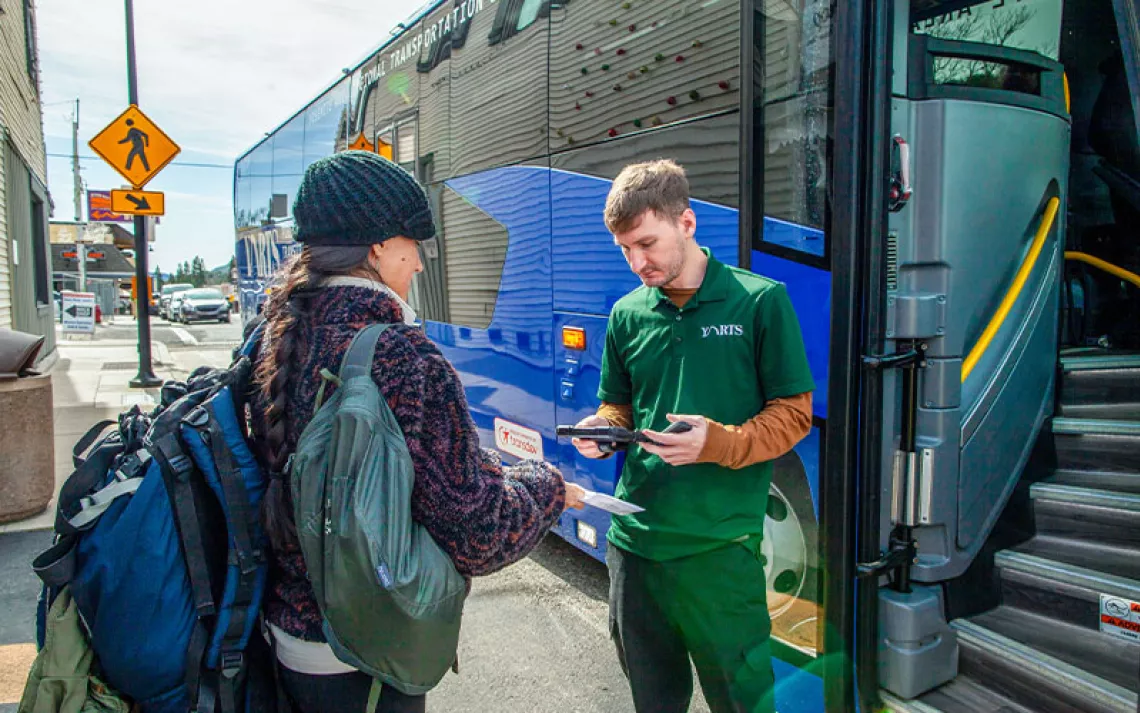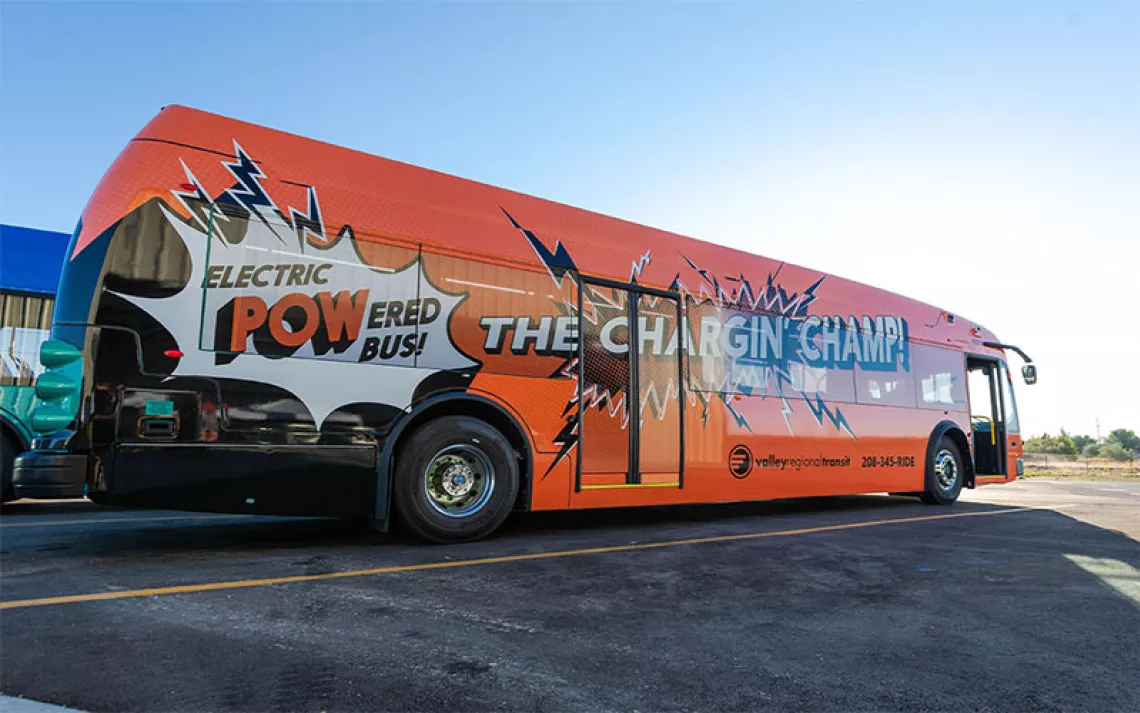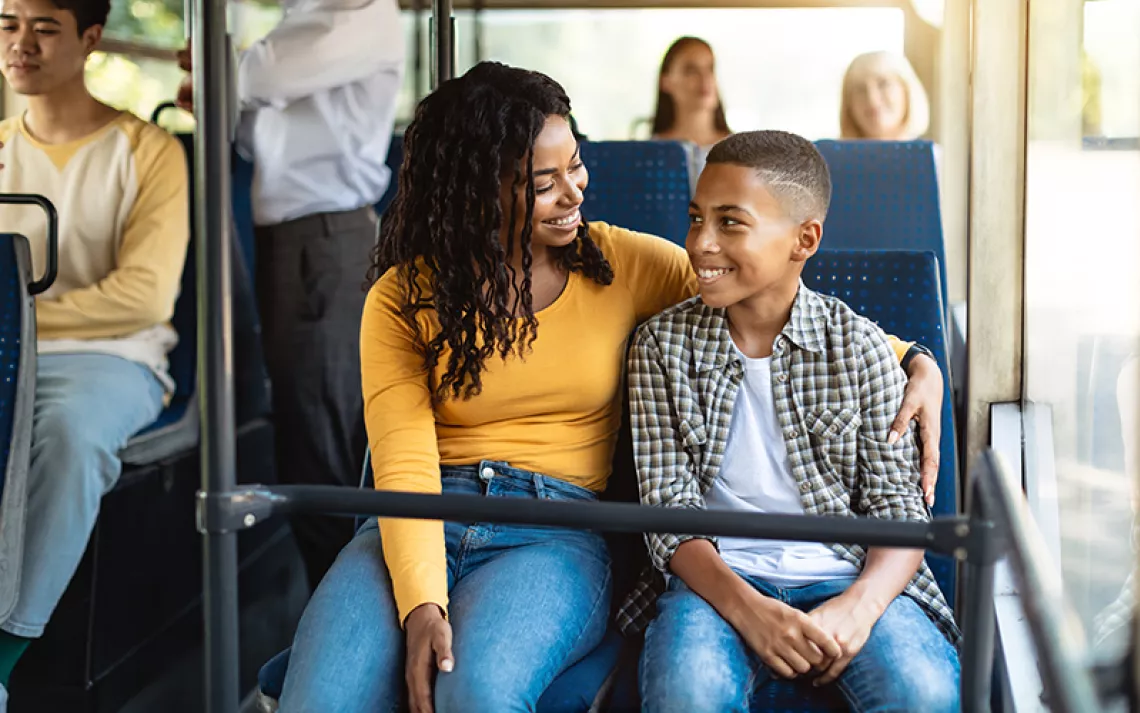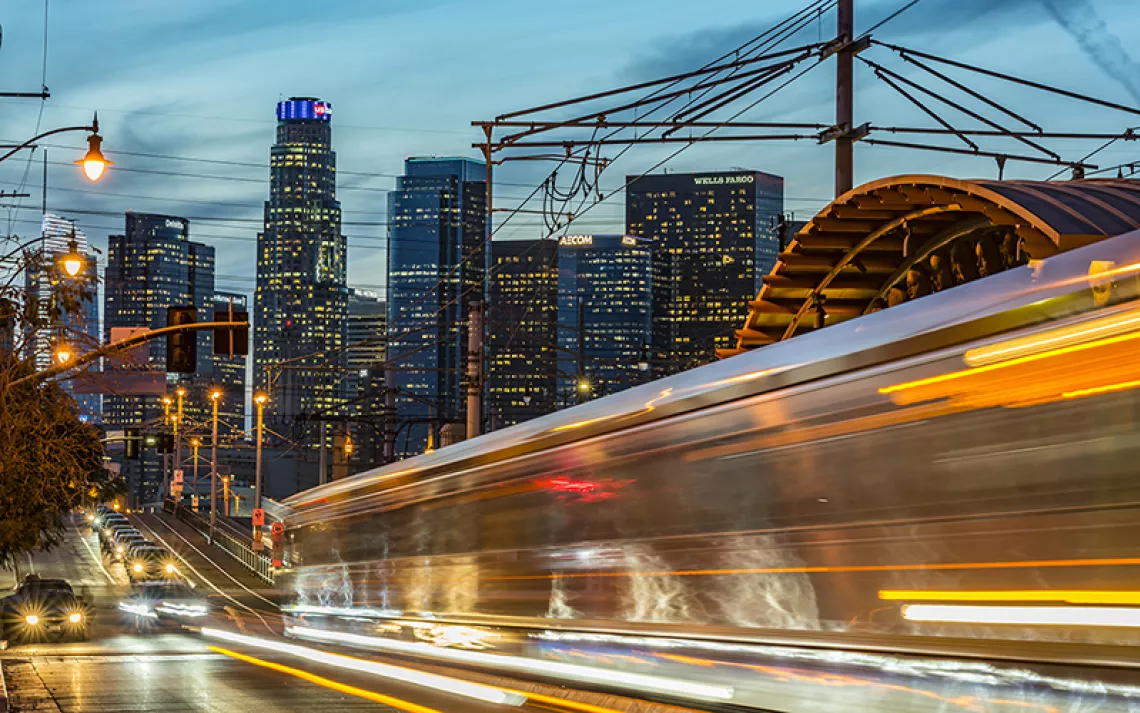My Cross-Country, Low-Carbon Road Trip
Climate activists need vacations too
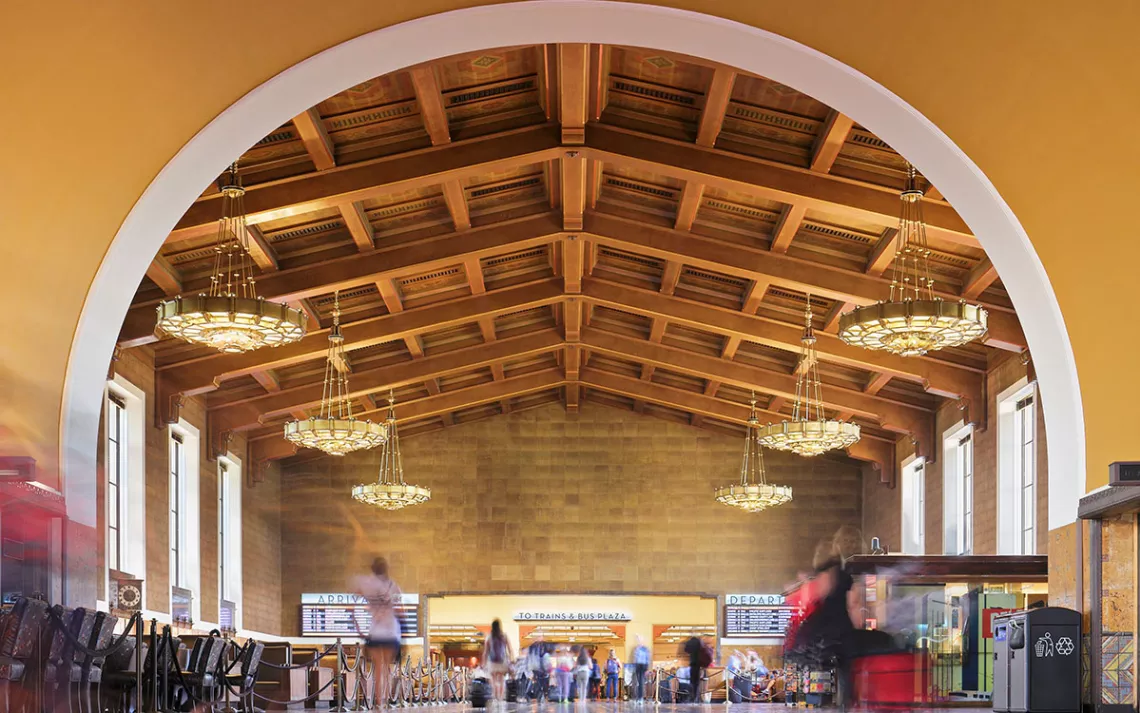
Union Station in Los Angeles. | Photo by S. Greg Panosian/iStock
I am a climate activist committed to serious policy change, but I also wanted a vacation. I had a big chunk of time off work, and I wanted to go snorkeling. I just didn’t want to fly to some tropical place from the Bay Area. My other parameters were not to spend too much money, to take public transportation as much as possible, to visit friends and family along the way, and to feel loose and free and have a lot of fun.
Part of this trip was me forging ahead as if a sustainable trip were possible, and sharing those possibilities. I also had to acknowledge where environmental and socially sustainable options just don’t exist. (I recently wrote about how individual change isn't so individual, because our individual actions take place in the context of social practices. For example, you can’t cut emissions by taking public transportation if the public transportation isn’t there.) I had to remember that I was trying to have fun—so I wasn’t going to bang my head too hard against things that don’t work.
To save money and have more of a sense of community, I decided to try hostels at my ripe old age of 63. Someone I know cringed when I said that because he had seen a horror movie about people being murdered in a hostel. I bought a USA Rail pass for $500 for the month and planned my route. Would I be able to read on the train, or would I get nauseous? Would I be able to sleep on the train? In a hostel? Would I get murdered? So many unknowns!
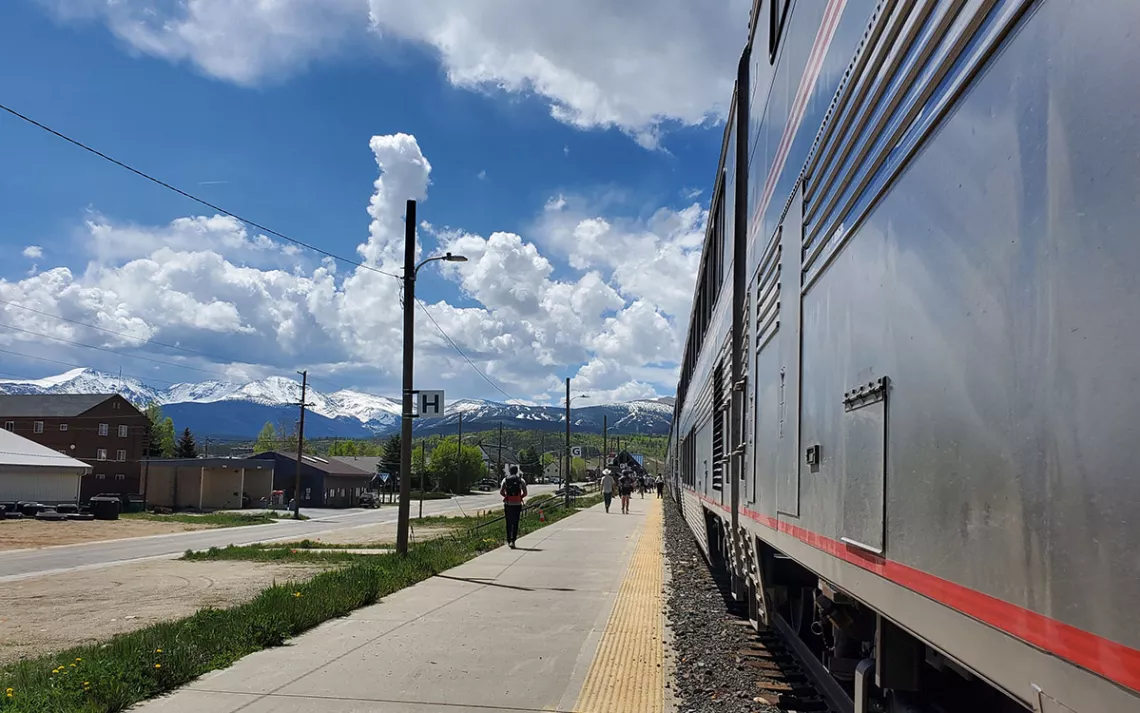
Summer snow in the Rockies as seen from the tracks in Fraser, Colorado. | Photo by Cynthia Kaufman
Day 1
Off to a great start. I take a Bay Area Rapid Transit train from Daly City, near my home, to Oakland. Get to the Jack London Amtrak station, a beautiful modern interpretation of a deco station with a statue of C.L. Dellums, an organizer for the old Brotherhood of Sleeping Car Porters and father of the former US representative Ron Dellums.
This is a slow travel trip. The train to LA takes 12 hours—driving takes 7. Of course it would be even faster to fly. But I didn’t want to travel like I was teleporting, trying to squash consciousness of the experience out of existence and just blip from point A to point B. Instead I had a lovely conversation with the woman next to me and enjoyed the scenery, especially the stunning stretch between Salinas and San Luis Obispo, a nostalgic trip back to an earlier California: Mission architecture. Fruit trees. People waving at the train. Rolling hills of grass and wildflowers.
Day 4
After two nice days with my family in LA, I have my first mishap. I show up Wednesday for the departure of my 10 p.m. overnight train to Tucson only to learn that it had left at 7:30. Apparently I’d been sent an email telling me about the change. The ticket agent says the next train is Sunday. I put my head in my hands and cry. She talks to another agent for a long time and they book me on a sold-out Friday-night train to New Orleans with no stop in Tucson. Too bad—I was really looking forward to the desert.
(I later learn this mix-up wouldn’t have happened had I been using the very good Amtrak mobile app. It keeps all your tickets in order with the QR codes easy to read and, most importantly, it updates the schedules.)
I spend two more days in LA, and without a car. It’s great. The first day, I walk 12 miles around the city, in Griffith Park and the restored LA River, now less industrial drainage ditch and more a lovely, tree-filled place to walk and bike. (I'm a big fan of the LA River, immortalized in the 1954 sci-fi film Them about giant ants taking over the city from the river. I grew up with an ant phobia from watching it too young, but I love the LA River all the same.) That evening my feet are trashed and I limp to a great dinner at a Chinese restaurant near the hotel. The next day, I take a bus across town to the Los Angeles County Museum of Art.
Day 6
Like everyone else, for years I've heard a lot of bad things about Amtrak: ridiculous delays, last-minute changes that get you off the train and onto a bus. But except for the communication snafu, everything’s great. The staff are uniformly pleasant, the announcements are clear and tell you what is going on. When the train needs to pull over for a freight to pass, they tell you how much time it will take. At stations, they encourage you to step out and stretch.
The trip from LA to New Orleans takes 48 hours. When I wake up the next morning, I did ask myself why I was doing this. It was A LOT of time to sit and stare out the window. But time passes in a way that makes me appreciate the privilege of my point in life where I don’t need to cram as much fun and relaxation as possible into a short stretch of time because I need to get back to the capitalist grindstone. I can enjoy a day looking out the window. I love the light rumble of the train. And I get a lot of reading done.
I spend a lot of time in the observation car, with its big windows, swiveled seats, and tables. It’s where you’re likely to run into people looking for conversation. I meet a guy who’s taking his first vacation after 35 years of work. He sprung for the $300 a night sleeper car and says he budgeted $14,000 for the whole trip. Otherwise, sleeping in a seat is fairly comfortable—for sleeping in a seat.
Day 8
The hostel in New Orleans is Madame Isabelle's—a beautiful old house with a big backyard, an outside deck, and a friendly cat. Everything is clean, and it’s quiet at night. My room has three bunks, each one with a curtain around it. I pay $53 per night. The other guests are mostly young people traveling for fun, lots of Canadians and Europeans. I’m happy to find a few other older women.
The hostel has bikes to rent for $15 a day. I find some good bike lanes, or at least curb cuts for the times when riding on the sidewalk seemed less dodgy. I wish for an app that would point out good places to ride; Google Maps tends to put you onto busy streets because they're faster but this is a SLOW TRAVEL trip.
My next goal is Montgomery Alabama, and there is no good way to get there and then to Miami by train, I decide to break down and rent a car. You can supposedly rent EVs from Hertz, and it’s cheaper than a gas car, but it turns out it is only for within a city and not for a one-way trip. So I rent an ICE (internal combustion engine) car for my drive to Montgomery to meet my friend Joann for a bit of civil rights tourism.
Day 13
I love Montgomery. The central part of town has a developed waterfront and the main street, Dexter Avenue, has beautifully preserved old storefronts. A lack of grocery stores makes it a bit of a food desert, but restaurants had amazing Southern food with plenty of vegetarian options: okra, greens, black-eyed peas, corn casserole, and the old standby, mac and cheese. I’m impressed by how much easier it is to be a vegetarian in the South compared with the last time I traveled through 30 years ago.
I wanted to go to Montgomery to visit the National Memorial to Peace and Justice, often referred to as the Lynching Museum. It is a profound work of art, a square city block close to the center of town with a set of interrelated works of art memorializing the traumas of slavery and lynching. There is nothing gratuitous, it was all informative and moving. I really appreciate the uncompromising clarity of the descriptive language used in the signage. It talked about racial terrorism and referred to those who left on the Great Migration as refugees.
Day 15
On to Nashville, where my friend and I spend two days going to museums, eating good food, and listening to music. We visited the recently opened National Museum of African American Music with its fun interactive exhibits. In each era of music, you could put on headphones and trace the influences and legacies of a whole host of artists. In Nashville, I'm impressed by little things: carpool lanes, a beautiful farmers' market with family-friendly bathrooms (which work as gender-neutral bathrooms without saying so), paper plates and bowls instead of Styrofoam, and in some places good recycling. Like Montgomery, Nashville is a great city for walking.
Next stop is Jacksonville, and back on the train to Miami.
Day 17
In Key Largo, I take a snorkeling boat out to a reef from John Pennekamp State Park, which is only a mile walk from the cute little mobile home where I'm staying. There’s even a safe bike lane along an ugly strip of highway, and a good grocery store close by.
Since I didn’t have a car, entry into the park was $2.50 instead of $4.50, although I have to inform the person taking the money about that. I guess they don't get too many walk-ins here. Next issue: Where to leave my stuff when I go in the water? There’s a place at the dive shop where people leave car keys, and after a bit of begging they agree to hold onto my daypack.
Snorkeling on the reef is amazing—some of the nicest coral I've ever seen. A crew person tells me that the soft corals are in great shape, but the park has had to work to foster growth of the hard, reef-building corals.
The next day, I hike around the mangroves in the park, then try to see if the water is clearer for snorkeling from the shore. It isn’t, so I go out on the boat again. For me there is nothing like pretending to be a fish.
Day 19
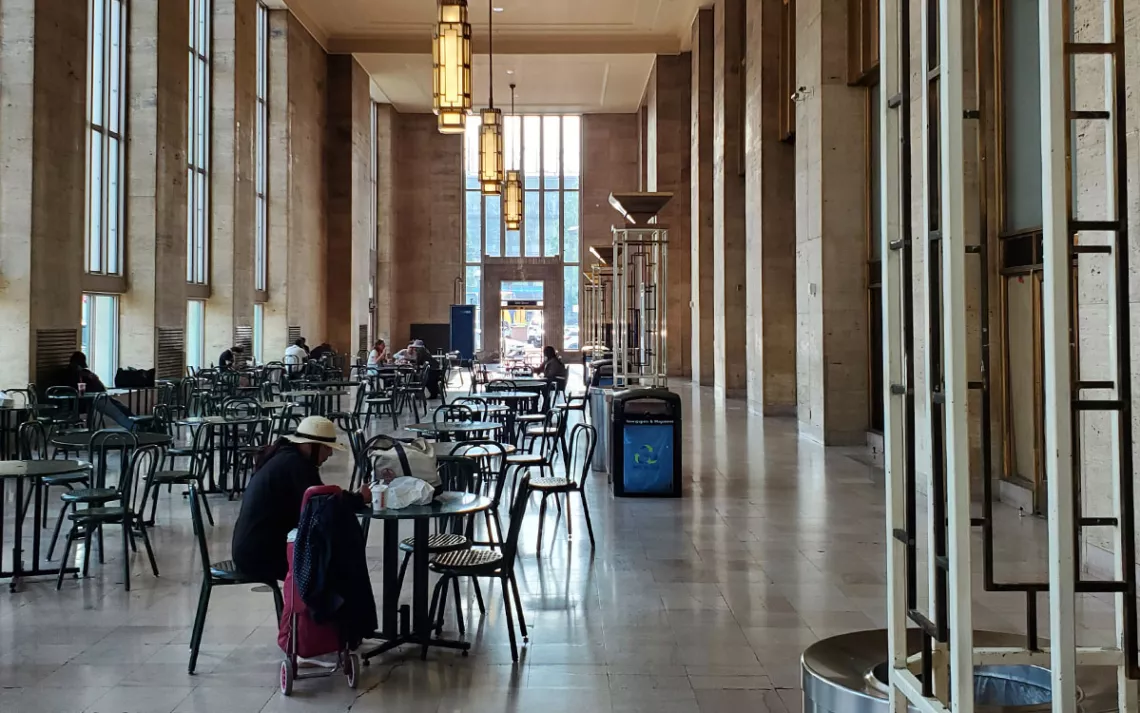
Philadelphia train station. | Photo by Cynthia Kaufman
I end up having to take a Lyft to and from Key Largo due to my own bad planning. A waste of money, but both times I get a Cuban driver who wants to speak in Spanish. In California, strangers almost never want to do that, but here even people working in grocery stores prefer Spanish. My second Lyft driver had only been in the country five weeks, and I was his first passenger. We have a great conversation the whole way, and I learn a lot about transitions in the Cuban economy.
On my walk back from the beach, there is a beautiful fruit stand with all sorts of tropical fruits. I feel like I’m in Mexico when I order a coco frio and the woman uses her machete to open up a locally grown coconut and put in a straw. Very refreshing.
Back to Miami and on to Charlotte, North Carolina, to visit my brother. The trains have all been clean and comfortable, but the one on the last leg to Charlotte is a whole step up—windows twice as big, nice carpet, and a much smoother ride.
After a nice family visit—which included playing a board game about trains, since my family thought I must be obsessed with them—I set off for Harrisburg, Pennsylvania, to visit my cousin. That train was late because of some technical problems, and the car I was in had no air conditioning or functioning bathroom. The conductor asks if anyone wanted to switch cars, and I am surprised to be one of the only ones who does. (This trip I am being medium Covid safe, and I really don't want to be in a car without air circulation.)
We got into Philadelphia an hour and a half late, so I missed my connection to Harrisburg. That gave me time to wander the station while waiting an hour for the next train.
Inside the Philadelphia station is really beautiful. It has huge windows, a lot of art deco details, and nice benches. It also has a really odd statue that is a tribute to the men and women of Amtrak who lost their lives serving in World War II, a 50-foot angel holding a deceased person who, to my eye, looks like a trans man—masculine face and upper body and a rather vulva-like set of genitals. Very forward looking of Amtrak.
I have a nice visit with my cousin Jennifer and wash all my laundry. I'm now on my way to New York City, Boston, New Hampshire, and then back home.
Day 25
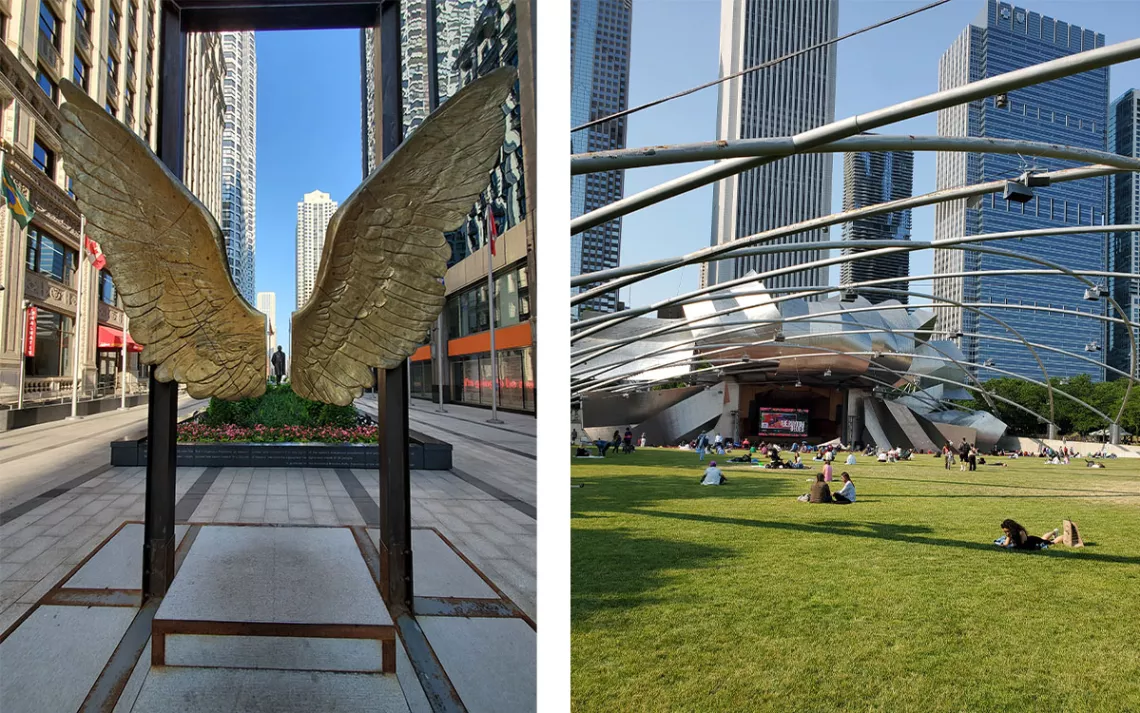
Left: If you stand in the right place, you can give this Chicago statue of Mexican president Benito Juarez wings. Right: My visit to Chicago coincided with the Chicago Blues Festival in Millennium Park. Only a short walk from the train station! | Photos by Cynthia Kaufman
The trip back is fun and easy. The whole trip, I never spent more than one night at a time on the train, which was about right. One night with odd sleep and no shower is fine; two or more would start to add up.
The most beautiful part of the train trip by far is Chicago to Salt Lake City. Illinois is a classic Norman Rockwell landscape—small farms with little silos, red barns, and softly rolling hills. I sleep through Nebraska, but the run from Denver to Salt Lake is spectacular. We cross the Rockies through several steep rocky gorges along the Colorado River, which only class five river rafters and train travelers ever get to see.
After a beautiful sunrise in Nevada, we come to another beautiful mountain pass through the Sierra Nevada. I’ve been on the road in this area many times and have often looked up at what looked like the very precarious train tracks and tunnels perched in the rocks above the highway. I’ve read about the Chinese laborers who built those tracks, working under incredibly harsh conditions, sometimes hanging in baskets to dynamite through the granite. Now here I am on those tracks and tunnels that they made passable.
I didn't realize that the long-distance Amtrak stopped in the Bay Area town of Richmond, which is much better than Oakland for me to get home. So I hop off early and take BART to Daly City, where my son’s boyfriend had left my car, all clean and full of electricity to get me home.
I'm happy with the traveling choices I made. It was a good idea to travel with a bowl, spork, cereal, tea, and powdered milk. The food on the train was OK and not overpriced, but I'd rather have my own breakfast than mediocre bagels or microwaved eggs. I carried snacks like cheese, crackers, power bars, and nuts for when I didn't feel like mac and cheese or grilled cheese. The Amtrak Greek salad, however, is actually not bad.
Other good choices were to have both a raincoat and an umbrella. The item I'm most glad I brought is a big, warm scarf. When walking around hot cities in a sundress, it helped to deal with the air conditioning indoors, or when the trains were too cold. It is also nice to have something to wrap around yourself when the steady rumble lulls you to sleep, dreaming of your next low-carbon adventure.
Read More: In a new report, the Sierra Club calls rail transportation "an unsung, but essential, solution to the climate emergency." Among its recommendations: "passenger train service must be appropriately fast, frequent, safe, and reliable."
 The Magazine of The Sierra Club
The Magazine of The Sierra Club
